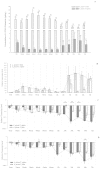Pea aphid Acyrthosiphon pisum sequesters plant-derived secondary metabolite L-DOPA for wound healing and UVA resistance
- PMID: 27006098
- PMCID: PMC4804291
- DOI: 10.1038/srep23618
Pea aphid Acyrthosiphon pisum sequesters plant-derived secondary metabolite L-DOPA for wound healing and UVA resistance
Abstract
Herbivores can ingest and store plant-synthesized toxic compounds in their bodies, and sequester those compounds for their own benefits. The broad bean, Vicia faba L., contains a high quantity of L-DOPA (L-3,4-dihydroxyphenylalanine), which is toxic to many insects. However, the pea aphid, Acyrthosiphon pisum, can feed on V. faba normally, whereas many other aphid species could not. In this study, we investigated how A. pisum utilizes plant-derived L-DOPA for their own benefit. L-DOPA concentrations in V. faba and A. pisum were analyzed to prove L-DOPA sequestration. L-DOPA toxicity was bioassayed using an artificial diet containing high concentrations of L-DOPA. We found that A. pisum could effectively adapt and store L-DOPA, transmit it from one generation to the next. We also found that L-DOPA sequestration verity differed in different morphs of A. pisum. After analyzing the melanization efficiency in wounds, mortality and deformity of the aphids at different concentrations of L-DOPA under ultraviolet radiation (UVA 365.0 nm for 30 min), we found that A. pisum could enhance L-DOPA assimilation for wound healing and UVA-radiation protection. Therefore, we conclude that A. pisum could acquire L-DOPA and use it to prevent UVA damage. This study reveals a successful co-evolution between A. pisum and V. faba.
Conflict of interest statement
The authors declare no competing financial interests.
Figures







Similar articles
-
Pea aphids, Acyrthosiphon pisum, suppress induced plant volatiles in broad bean, Vicia faba.J Chem Ecol. 2011 Oct;37(10):1055-62. doi: 10.1007/s10886-011-0006-5. Epub 2011 Aug 26. J Chem Ecol. 2011. PMID: 21870158
-
Limited effects of the maternal rearing environment on the behaviour and fitness of an insect herbivore and its natural enemy.PLoS One. 2019 Jan 11;14(1):e0209965. doi: 10.1371/journal.pone.0209965. eCollection 2019. PLoS One. 2019. PMID: 30633753 Free PMC article.
-
Conditional facilitation of an aphid vector, Acyrthosiphon pisum, by the plant pathogen, pea enation mosaic virus.J Insect Sci. 2010;10:155. doi: 10.1673/031.010.14115. J Insect Sci. 2010. PMID: 21067425 Free PMC article.
-
Sieve element occlusion: Interactions with phloem sap-feeding insects. A review.J Plant Physiol. 2022 Feb;269:153582. doi: 10.1016/j.jplph.2021.153582. Epub 2021 Dec 5. J Plant Physiol. 2022. PMID: 34953413 Review.
-
Systemic analysis of the symbiotic function of Buchnera aphidicola, the primary endosymbiont of the pea aphid Acyrthosiphon pisum.C R Biol. 2009 Nov;332(11):1034-49. doi: 10.1016/j.crvi.2009.09.007. Epub 2009 Oct 14. C R Biol. 2009. PMID: 19909925 Review.
Cited by
-
Morphological and biological characterization of a light-colored mutant in the multicolored Asian lady beetle, Harmonia axyridis.Ecol Evol. 2018 Oct 3;8(20):9975-9985. doi: 10.1002/ece3.4379. eCollection 2018 Oct. Ecol Evol. 2018. PMID: 30397440 Free PMC article.
-
The L-DOPA/Dopamine Pathway Transgenerationally Regulates Cuticular Melanization in the Pea Aphid Acyrthosiphon pisum.Front Cell Dev Biol. 2020 May 5;8:311. doi: 10.3389/fcell.2020.00311. eCollection 2020. Front Cell Dev Biol. 2020. PMID: 32432113 Free PMC article.
-
Deciphering the Function of Octopaminergic Signaling on Wing Polyphenism of the Pea Aphid Acyrthosiphon pisum.Front Physiol. 2016 Dec 9;7:603. doi: 10.3389/fphys.2016.00603. eCollection 2016. Front Physiol. 2016. PMID: 28018234 Free PMC article.
-
Dietary L-3,4-dihydroxyphenylalanine (L-DOPA) augments cuticular melanization in Anopheles mosquitos while reducing their lifespan and malaria parasite burden.bioRxiv [Preprint]. 2025 Mar 20:2024.09.30.615839. doi: 10.1101/2024.09.30.615839. bioRxiv. 2025. PMID: 40166253 Free PMC article. Preprint.
-
Assessment of oxidative stress and activities of antioxidant enzymes depicts the negative systemic effect of iron-containing fertilizers and plant phenolic compounds in the desert locust.Environ Sci Pollut Res Int. 2016 Nov;23(21):21989-22000. doi: 10.1007/s11356-016-7391-9. Epub 2016 Aug 18. Environ Sci Pollut Res Int. 2016. PMID: 27539469
References
-
- Williams I. S. & Dixon A. F. G. 3 Life Cycles and Polymorphism. Aphids as Crop Pests 69–86(doi: 10.1079/9780851998190.0000) (2007). - DOI
-
- Schoonhoven L., Jermy T. & Van Loon J. Plants as insect food: not the ideal. Insect-Plant Biology Chapter 4, 83–120(doi: 10.1007/978-1-4899-3200-6_4) (1998). - DOI
-
- Goggin F. L. Plant-aphid interactions: molecular and ecological perspectives. Curr Opin Plant Biol 10, 399–408 (2007). - PubMed
-
- Carton Y. Poirie. M. & Nappi A. J. Insect immune resistance to parasitoids. Insect Sci 15, 67–87 (2008).
Publication types
MeSH terms
Substances
LinkOut - more resources
Full Text Sources
Other Literature Sources

